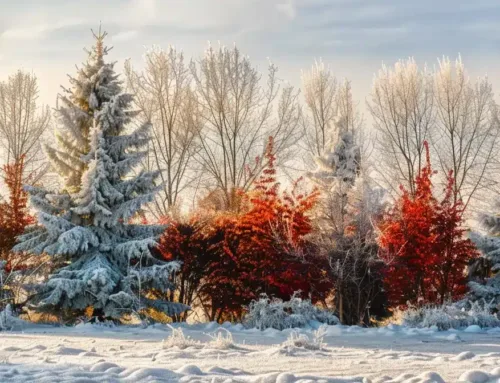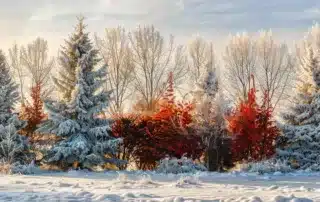Winter can be tough on your trees and shrubs, often leading to freezing temperatures that pose significant risks to their health. Many homeowners might overlook crucial maintenance during this season, which can result in long-term damage. In this post, I’ll share essential strategies for protecting your plants, including how to prevent winter injury in deciduous trees and best practices for managing snow and ice impacts. By understanding these methods, you can ensure your landscape remains vibrant, minimizing risks like transpiration loss and animal damage. Let’s dive into effective winter care for your trees and shrubs.
Understanding Winter Care for Trees and Shrubs

Preparing your trees and shrubs for winter is vital to their health and longevity. Seasonal care from landscaping services protects against common stress factors like disease, freezing temperatures, and damage from deicing materials. I’ll discuss how to safeguard budding plants, such as rhododendrons, and the importance of using wire to support vulnerable branches. These strategies about landscape architecture will help ensure your landscape thrives come spring.
Importance of Seasonal Preparation
Seasonal preparation is crucial for enhancing the resilience of trees and shrubs during winter. Newly exposed tissue can become vulnerable to cold temperatures and harsh weather conditions, leading to potential wounds that may affect their health. By taking proactive measures, like protecting sensitive plants with mulch and ensuring adequate hydration, landscaping services can help these plants withstand the challenges of winter and ensure that they not only survive but thrive in the coming spring. Learning more about landscape architecture can further optimize the health and aesthetics of your garden throughout the year.
Common Winter Stress Factors
During winter, trees and shrubs face several stress factors that can hinder their growth and health. Wind can dry out branches, while frost heaving may uproot delicate plants like taxus baccata, causing instability. Additionally, variations in precipitation can lead to either drought or excess moisture, both of which negatively impact plant vitality. To mitigate these issues, I recommend using fences or barriers that provide windbreaks and prevent excessive snow accumulation around sensitive plants. For more information about landscape architecture, consider consulting professional landscaping services.
Winter is harsh, but the strength of trees and shrubs lies below the surface. Understanding how to protect roots from cold damage will keep your landscape healthy through the frost.
Protecting Roots From Cold Damage

To protect roots from cold damage, I focus on techniques for insulating roots effectively. Proper management of soil moisture plays a critical role in maintaining healthy roots throughout the winter. Using materials like leaves as organic mulch and integrating windbreaks can help shield plants from harsh winds and unwanted rodents that may disturb the soil. Utilizing landscaping services and integrating about landscape architecture can help ensure your landscape thrives.
Techniques for Insulating Roots
To effectively insulate roots from cold damage, I recommend applying a thick layer of organic mulch around the base of your trees and shrubs. This layer serves not only to stabilize soil temperature but also to prevent injury from freezing conditions. Additionally, protecting the bark against issues like girdling is crucial; using protective wraps from landscaping services can shield young trees from insect activity and ice storms that might otherwise compromise their health during harsh winter months. For more information about landscape architecture, consider consulting with professionals who specialize in creating resilient and aesthetically pleasing outdoor environments.
Soil Temperature Management
Managing soil temperature during winter is crucial for protecting the roots of trees and shrubs from extreme weather conditions. When plants enter dormancy, they need a stable environment that includes adequate moisture and insulation from freezing temperatures. I recommend monitoring soil moisture levels carefully and applying a balanced fertilizer in late fall to strengthen roots before the ground hardens. This simple approach can significantly enhance their resilience against winter stressors. Additionally, utilizing landscaping services can provide professional expertise to further support your garden’s health during the colder months.
As the frost sets in, the strength of our trees hangs in the balance. Understanding how to prevent winter injury in deciduous trees will safeguard their future.
Preventing Winter Injury in Deciduous Trees

Identifying vulnerable tree species like Thuja is essential for preventing winter injury in deciduous trees. I focus on protecting against sun scald damage, which can be a real threat to the health of your trees. Additionally, understanding how to recover from winter injuries ensures that your landscape remains vibrant with the help of landscaping services, even after the cold months, while keeping wildlife and deer at bay. To further support your efforts, learning about landscape architecture can provide valuable insights.
Identifying Vulnerable Tree Species
Identifying vulnerable tree species is essential in preventing winter injury, especially in our Illinois hardiness zones. Trees such as red maples and young birches are particularly susceptible to drought stress and damaging fungus during the cold months. In my experience at bret-mar landscape, offering landscaping services and providing insights about landscape architecture—like thoroughly assessing soil conditions and providing extra protection to these sensitive varieties—makes a significant difference in their health and resilience come spring.
Protecting Against Sunscald Damage
To protect your landscape from sunscald damage, particularly in deciduous trees like maple and oak, I recommend using burlap wraps or tree guards, which are often provided by landscaping services. These materials can provide essential shade and insulation for young trees, especially those that may face direct sunlight on warm winter days. Additionally, I encourage proper landscape design that considers tree placement and the use of structures like roofs or overhangs to shield vulnerable trees from harsh sun exposure, enhancing their resilience against winter stressors. For more information about landscape architecture, consult a professional.
Recovering From Winter Injuries
Recovering from winter injuries requires a thoughtful approach to horticulture and landscaping services and a keen eye for potential issues, such as pests that may be drawn to stressed plants. After heavy snowfalls, I often advise applying a layer of mulch around injured trees, like holly, to keep their roots insulated and promote healthy regrowth. Timely inspections and proper care, including pruning damaged branches, contribute toward rejuvenating your landscape, ensuring your trees are resilient and ready for the next growing season. Understanding about landscape architecture can further enhance your landscaping efforts.
Deciduous trees need care to survive the cold months. Evergreens, with their sturdy needles, also require attention to thrive through winter‘s grip.
Winter Care Strategies for Evergreens

Winter Care Strategies for Evergreens
Assessing frost damage in evergreens is essential as this helps identify species that may need extra care. Proper watering techniques before winter protect the wood and roots from stress caused by extreme climate changes. Additionally, landscaping services will help with pruning considerations for the cold months, ensuring your evergreens are healthy and resilient through the winter. Each of these strategies plays a key role in maintaining the vitality of your landscape, showcasing our expertise about landscape architecture.
Assessing Frost Damage in Evergreens
When assessing frost damage in evergreens as part of landscaping services, I carefully inspect the trunk and branches for any signs of browning or needle drop. It’s important to focus on how these indicators relate to overall tree care; damaged areas can make the tree susceptible to pests, which may further impact its health. I often recommend applying a layer of woodchips around the base to aid in moisture retention and provide additional protection as the temperatures fluctuate, ensuring your evergreens remain robust throughout the colder months about landscape architecture.
Proper Watering Techniques Before Winter
Before winter sets in, ensuring your evergreens are well-hydrated is essential to combat desiccation. As an arborist, I always advise homeowners to water deeply in autumn, allowing moisture to penetrate the root zone. This practice, recommended by landscaping services, not only helps maintain healthy lawn and tree conditions but also prepares the plants for the stresses of winter, making them more resilient against the cold. Homeowners interested in learning about landscape architecture can further enhance their garden’s resilience.
Pruning Considerations for Cold Months
When it comes to pruning evergreens during the colder months, it’s crucial to focus on enhancing their hardiness and overall beauty. I always recommend assessing the branch structure before any cuts, especially after a winter storm, as damaged limbs can weaken the tree and pose a risk to surrounding areas. Understanding about landscape architecture can further aid in maintaining tree health and aesthetic appeal. Additionally, I utilize compost around the base post-pruning to facilitate healthy growth and improve soil quality, which supports effective irrigation as the seasons shift, complementing professional landscaping services.
Even well-cared-for evergreens face challenges as the snow piles high. It’s essential to know how to protect them from the weight and icy grips of winter‘s chill.
Managing Snow and Ice Impacts

Minimizing damage from snow and ice is essential for the health of your trees and shrubs. In this section, I’ll cover techniques to reduce breakage, how to remove heavy snow safely, and the impact of road salt on both perennial plants and evergreens like pine. These insights will help you protect your landscape from winter stresses and promote healthy growth come spring. For additional support, consider utilizing professional landscaping services or exploring more about landscape architecture.
Techniques to Minimize Breakage
To minimize breakage in evergreens during winter, I recommend gently shaking off heavy snow accumulation from branches rather than using forceful methods, which can cause more damage. Regularly inspecting your trees with the help of landscaping services for signs of stress or damage allows for timely intervention—pruning any weak or damaged limbs can also prevent future breakage. Additionally, constructing support structures around particularly vulnerable evergreens using landscaping services can safeguard them against the weight of ice and snow, helping to maintain their health throughout the winter months.
Removing Heavy Snow Safely
When it comes to removing heavy snow from your trees and shrubs, I always approach the task with care to prevent damage. If you prefer professional help, consider hiring landscaping services. I recommend using a broom or a soft brush to gently sweep snow off the branches, avoiding any forceful actions that could break limbs. Additionally, landscaping services can assist in maintaining the structural integrity of your plants, ensuring they can withstand the weight of ice and snow, promoting their overall health as spring approaches.
Effects of Road Salt on Trees and Shrubs
Road salt, commonly used for deicing sidewalks and roads, can have damaging effects on trees and shrubs if not managed properly. I’ve seen firsthand how salt can lead to leaf scorch and even root damage, particularly in evergreens, as the high sodium content disrupts the plants’ ability to absorb water. To protect your landscape, I recommend creating buffer zones with mulch or using salt alternatives in areas close to your plants, ensuring they remain healthy and vibrant throughout the winter months. For additional support, consider hiring landscaping services or learning about landscape architecture. Professional landscaping services can provide effective strategies to maintain your garden’s health despite the challenges posed by road salt.
As the snow melts, a different threat emerges. Protecting your trees and shrubs becomes crucial, for nature’s creatures seek sustenance in the beauty you’ve cultivated.
Protecting Trees and Shrubs From Animal Damage

Protecting your trees and shrubs from animal damage during winter is essential for their survival. I’ll cover effective deterrents that can be implemented by landscaping services for browsing animals, which help minimize unwanted feeding. Additionally, I’ll discuss using protective barriers and wraps that safeguard delicate bark and foliage from critters. Learning about landscape architecture can aid in designing these strategies, ensuring your landscape remains healthy and intact through the colder months.
Deterrents for Browsing Animals
To deter browsing animals from feasting on your trees and shrubs, I recommend using a combination of physical barriers and natural repellents. Installing tree guards made of hardware cloth or plastic fencing can effectively protect young plants, while applying a mixture of soap and water to the foliage can create an unappealing taste for many herbivores. In my experience, these simple yet effective strategies, often utilized by landscaping services, can significantly reduce damage from deer and other wildlife, helping your landscape remain untouched throughout the winter months. For more information about landscape architecture, consider consulting a professional.
Protective Barriers and Wraps
To effectively safeguard your trees and shrubs from animal damage during winter, I often utilize protective barriers and wraps as part of my landscaping services. Installing tree guards made from materials like hardware cloth or plastic fencing around young plants creates a physical barrier that deters browsing animals. In my landscaping services, using these wraps not only protects the delicate bark from gnawing but also ensures that your plants can withstand the winter months without significant harm, allowing them to thrive come spring.
While you’ve shielded your trees and shrubs from harm, the colder months demand another layer of attention from landscaping services. Let’s explore essential tips about landscape architecture that will keep your landscape thriving through winter‘s chill.
Essential Tips for Winter Care Maintenance

Essential Tips for Winter Care Maintenance
Creating a winter care schedule is vital for ensuring the health of your trees and shrubs. I will discuss recommended tools for effective winter maintenance, like protective wraps and mulch from landscaping services, as well as resources that provide seasonal guidance about landscape architecture. These insights will help you stay organized and informed throughout the colder months, setting the stage for a thriving landscape come spring.
Creating a Winter Care Schedule
Creating a winter care schedule is essential for maintaining the vitality of your trees and shrubs throughout the colder months. I recommend setting aside specific times to check soil moisture levels, apply mulch, and ensure that any protective wraps are secure. By organizing these tasks into a weekly or bi-weekly routine and consulting about landscape architecture, I can help ensure that my landscape remains healthy and resilient, ready to flourish come spring with the support of landscaping services.
Recommended Tools for Winter Maintenance
For effective winter maintenance, I recommend a few essential tools that can make a significant difference in caring for your trees and shrubs. A sturdy shovel and mulch spreader are crucial for managing snow and applying protective mulch, which insulates roots and stabilizes soil temperature. Additionally, using protective wraps and tree guards through landscaping services can help shield young plants from harsh winter elements and animal damage, ensuring that your landscape remains healthy and resilient during the colder months.
Term:
Resources for Seasonal Guidance
For effective winter care maintenance, I recommend utilizing available resources that guide landscape preservation and offer insights about landscape architecture. Local extension services often provide valuable insights tailored to our Illinois climate, including seasonal care checklists and best practices for tree and shrub protection. Additionally, gardening books and online forums focused on horticulture can offer practical tips from fellow enthusiasts, helping you address any concerns while ensuring your plants thrive through the cold months. Furthermore, landscaping services can assist in implementing these strategies effectively.
Conclusion
Winter care for your trees and shrubs is essential for their health and longevity. By preparing your landscape with proper insulation, hydration, and protective measures, you can help your plants withstand harsh temperatures and stressors. Implementing effective strategies such as using mulch, applying protective wraps, and monitoring moisture levels ensures your landscape will thrive when spring arrives. Prioritizing these winter care essentials not only safeguards your plants but also enhances the beauty and resilience of your property for years to come.




